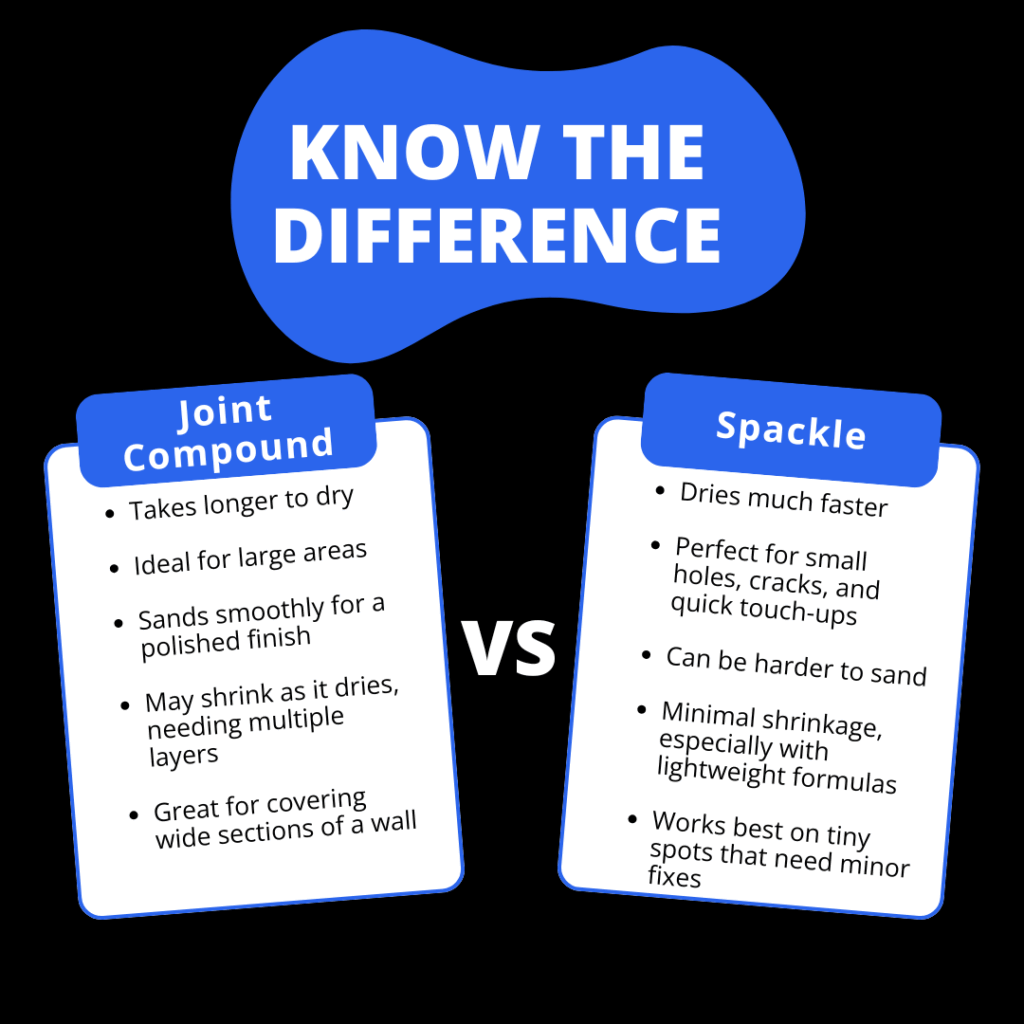Fixing walls may seem simple, but choosing the wrong product can lead to messy results. Many people don’t know the difference between joint compound and spackle. They’re often used the same way, but they are not the same thing. If you’re patching drywall or preparing your home for painting, knowing when to use joint compound vs spackle can save time, money, and frustration.
This guide will help you choose the right one for your project.
Clearing Up the Confusion
Both joint compound and spackle are used to smooth and repair walls. They look similar and are applied the same way, but they work best for different jobs.
Choosing the right one depends on what kind of repair you’re doing. Are you fixing a small nail hole or covering an entire drywall seam? The answer will point you to the right product.

What Is Joint Compound?
Joint compound, sometimes called drywall mud, is a thick paste used for finishing new drywall. It’s made from gypsum and comes in large buckets or boxes. You apply it with a putty knife and sand it down once it dries.
Most people use joint compound to:
- Cover seams between drywall sheets
- Embed drywall tape
- Smooth out large wall areas
- Fix deeper holes or dents
It takes longer to dry than spackle, but it’s easier to sand for a smooth finish.
Cost tip: A 5-gallon bucket of joint compound costs around $15 to $25, and it covers a lot of surface area. This makes it a budget-friendly option for bigger jobs.
What Is Spackle?
Spackle is used for smaller repairs. It has a thicker texture and dries faster than joint compound. It’s ideal for filling tiny holes, like those left by picture nails or screws.
There are two main types:
- Lightweight spackle: great for fast-drying, minor repairs
- All-purpose spackle: thicker and works on deeper dents
Because spackle comes in small tubs, it’s perfect for quick touch-ups. You can usually paint over it the same day.
Cost tip: A small 8 to 16 oz tub of spackle costs about $4 to $10.
Key Differences That Matter
Still not sure which one to grab off the shelf? Here’s a side-by-side look at how joint compound vs spackle stack up:
Drying Time
- Joint Compound: Takes longer to dry, sometimes up to 24 hours.
- Spackle: Dries much faster, often within 15 to 30 minutes.
Best Use
- Joint Compound: Ideal for large areas, drywall seams, and deep repairs.
- Spackle: Perfect for small holes, cracks, and quick touch-ups.
Ease of Sanding
- Joint Compound: Sands smoothly for a polished finish.
- Spackle: Can be harder to sand, especially thicker spots.
Shrinkage
- Joint Compound: May shrink as it dries, needing multiple layers.
- Spackle: Minimal shrinkage, especially with lightweight formulas.
Surface Area
- Joint Compound: Great for covering wide sections of wall.
- Spackle: Works best on tiny spots that need minor fixes.
This breakdown can help you pick the right one with confidence, no guesswork needed.
When Joint Compound Works Best
Joint compound is the go-to for bigger projects. Use it when:
- You’re taping and finishing new drywall
- The hole or damage is large or deep
- You need to blend into the wall for painting
- Multiple wall areas need repair at once
Even though it dries slowly, the results are smoother and longer-lasting for big jobs.
When Spackle Works Best
Spackle is perfect for:
- Filling small nail or screw holes
- Touch-ups before a home showing or paint job
- Jobs where time is limited and fast drying matters
- Keeping in your toolkit for quick home fixes
Because it dries so quickly, it’s a favorite for quick repairs. You can sand and paint within the hour.
Common Mistakes to Avoid
To get the best results, avoid these common errors:
- Using spackle for big holes. It can crack or fall out.
- Painting too soon. Always wait until it’s fully dry.
- Skipping sanding. Un-smooth patches will show through paint.
- Overfilling with joint compound. It will take forever to dry and may shrink unevenly.

Always check the label for drying times and use a putty knife for a clean finish.
Related Questions
Is one stronger or more durable than the other?
Joint compound is more durable and flexible for larger jobs. It can handle expansion and contraction of wall surfaces better than spackle. Spackle is more brittle when dry. Over time, in areas with high moisture or vibration, it may crack or chip if used inappropriately (e.g., over a large area or deep gouge).
Which is better for nail holes?
Spackle is ideal for small nail or screw holes. It spreads easily, dries fast, and requires minimal sanding. Use lightweight spackle for the fastest results. Just press it in with a putty knife, scrape smooth, let it dry, and paint.
Can I paint over spackle or joint compound?
Yes, but always prime first. Both spackle and joint compound are very porous, and if painted directly, they’ll cause blotchy or dull spots on the wall. Use a drywall primer or a primer-sealer to ensure a consistent paint finish.
What Pros Say About Choosing the Right Product
Professional contractors often use both, depending on the job. For example, they may use spackle for a few holes but switch to joint compound when working on new drywall or larger repairs.
At Enviroquest, we’ve seen many wall repairs go wrong just because the wrong material was used. Knowing when to use joint compound vs spackle keeps walls smooth and reduces rework. It’s especially helpful during property turnovers, remodels, or before repainting.
Simple Prep Tips for Smoother Results
- Clean the area before applying anything
- Use the right size putty knife for control
- Apply in thin layers, especially with joint compound
- Let it dry completely before sanding or painting
- Prime the area if you’re painting over it
Keeping a small tub of spackle in your toolbox is always a good idea for last-minute fixes.
Know What’s Behind the Wall Too
Using the right product on the surface is important, but so is knowing what’s going on behind the wall. Mold, moisture, or hidden damage can affect how well repairs hold.
If you’re fixing walls in a basement, bathroom, or any area prone to dampness, it might be time to consider a professional mold inspection. Catching issues early can save you time and protect your home long-term.
Final Take: Which One Should You Use?
It comes down to size and purpose.
- Use spackle for small, shallow holes and quick touch-ups.
- Use joint compound for large, deep areas or when finishing drywall seams.
They each have a purpose. Use the right one and your repairs will last longer and look better.
